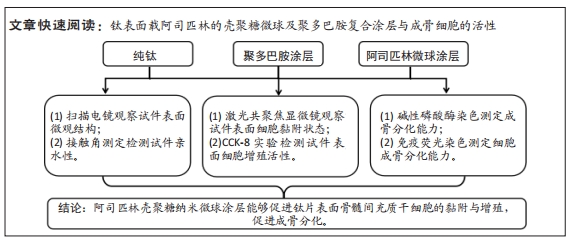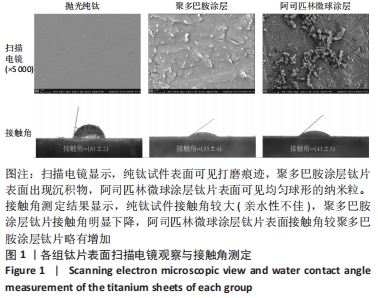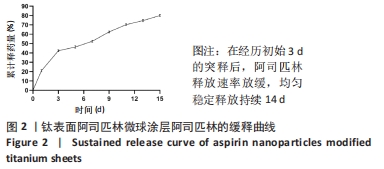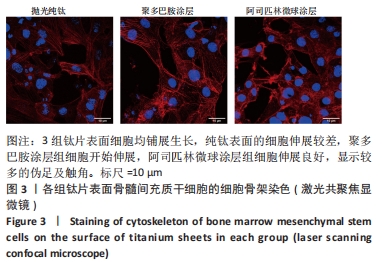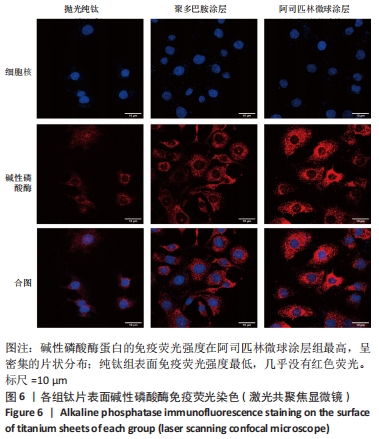[1] AHN TK, LEE DH, KIM TS, et al. Modification of Titanium Implant and Titanium Dioxide for Bone Tissue Engineering. Adv Exp Med Biol. 2018; 1077: 355-368.
[2] OSHIDA Y, TUNA EB, AKTöREN O, et al. Dental implant systems. Int J Mol Sci. 2010;11(4):1580-1678.
[3] CHRCANOVIC BR, ALBREKTSSON T, WENNERBERG A. Reasons for failures of oral implants. J Oral Rehabil. 2014;41(6):443-476.
[4] KIM TI, JANG JH, KIM HW, et al. Biomimetic approach to dental implants. Curr Pharm Des. 2008;14(22):2201-2211.
[5] HE Y, MU C, SHEN X, et al. Peptide LL-37 coating on micro-structured titanium implants to facilitate bone formation in vivo via mesenchymal stem cell recruitment. Acta Biomater. 2018;80:412-424.
[6] LE GUéHENNEC L, SOUEIDAN A, LAYROLLE P, et al. Surface treatments of titanium dental implants for rapid osseointegration. Dent Mater. 2007;23(7):844-854.
[7] CHIEN CY, LIU TY, KUO WH, et al. Dopamine-assisted immobilization of hydroxyapatite nanoparticles and RGD peptides to improve the osteoconductivity of titanium. J Biomed Mater Res A. 2013;101(3): 740-747.
[8] MAIER GP, RAPP MV, WAITE JH, et al. BIOLOGICAL ADHESIVES. Adaptive synergy between catechol and lysine promotes wet adhesion by surface salt displacement. Science. 2015;349(6248): 628-632.
[9] GUO Q, CHEN J, WANG J, et al. Recent progress in synthesis and application of mussel-inspired adhesives. Nanoscale. 2020;12(3): 1307-1324.
[10] FUSTER V, SWEENY JM. Aspirin: a historical and contemporary therapeutic overview. Circulation. 2011;123(7):768-778.
[11] CHIN KY. A Review on the Relationship between Aspirin and Bone Health. J Osteoporos. 2017;2017:3710959.
[12] DU J, MEI S, GUO L, et al. Platelet-rich fibrin/aspirin complex promotes alveolar bone regeneration in periodontal defect in rats. J Periodontal Res. 2018;53(1):47-56.
[13] DU M, PAN W, DUAN X, et al. Lower dosage of aspirin promotes cell growth and osteogenic differentiation in murine bone marrow stromal cells. J Dent Sci. 2016;11(3):315-322.
[14] PAñOS I, ACOSTA N, HERAS A. New drug delivery systems based on chitosan. Curr Drug Discov Technol. 2008;5(4):333-341.
[15] RAJITHA P, GOPINATH D, BISWAS R, et al. Chitosan nanoparticles in drug therapy of infectious and inflammatory diseases. Expert Opin Drug Deliv. 2016;13(8):1177-1194.
[16] PAN C, QIAN J, ZHAO C, et al. Study on the relationship between crosslinking degree and properties of TPP crosslinked chitosan nanoparticles. Carbohydr Polym. 2020;241:116349.
[17] SPRIANO S, YAMAGUCHI S, BAINO F, et al. A critical review of multifunctional titanium surfaces: New frontiers for improving osseointegration and host response, avoiding bacteria contamination. Acta Biomater. 2018;79:1-22.
[18] BANDYOPADHYAY A, SHIVARAM A, MITRA I, et al. Electrically polarized TiO(2) nanotubes on Ti implants to enhance early-stage osseointegration. Acta Biomater. 2019;96:686-693.
[19] NOZAKI K, WANG W, HORIUCHI N, et al. Enhanced osteoconductivity of titanium implant by polarization-induced surface charges. J Biomed Mater Res A. 2014;102(9):3077-3086.
[20] ZHAO QM, SUN YY, WU CS, et al. Enhanced osteogenic activity and antibacterial ability of manganese-titanium dioxide microporous coating on titanium surfaces. Nanotoxicology. 2020;14(3):289-309.
[21] SOUZA JCM, SORDI MB, KANAZAWA M, et al. Nano-scale modification of titanium implant surfaces to enhance osseointegration. Acta Biomater. 2019;94:112-131.
[22] TSAI WB, CHEN WT, CHIEN HW, et al. Poly(dopamine) coating to biodegradable polymers for bone tissue engineering. J Biomater Appl. 2014;28(6):837-848.
[23] SAMYN P. A platform for functionalization of cellulose, chitin/chitosan, alginate with polydopamine: A review on fundamentals and technical applications. Int J Biol Macromol. 2021;178:71-93.
[24] JIA L, HAN F, WANG H, et al. Polydopamine-assisted surface modification for orthopaedic implants. J Orthop Translat. 2019;17:82-95.
[25] HAZEKAWA M, KOJIMA H, HARAGUCHI T, et al. Effect of Self-healing Encapsulation on the Initial Burst Release from PLGA Microspheres Containing a Long-Acting Prostacyclin Agonist, ONO-1301. Chem Pharm Bull (Tokyo). 2017;65(7):653-659.
[26] HULBERT SF, YOUNG FA, MATHEWS RS, et al. Potential of ceramic materials as permanently implantable skeletal prostheses. J Biomed Mater Res. 1970;4(3):433-456.
[27] DOU X, WEI X, LIU G, et al. Effect of porous tantalum on promoting the osteogenic differentiation of bone marrow mesenchymal stem cells in vitro through the MAPK/ERK signal pathway. J Orthop Translat. 2019;19:81-93.
[28] WANG X, SCHRöDER HC, MüLLER WE. Enzymatically synthesized inorganic polymers as morphogenetically active bone scaffolds: application in regenerative medicine. Int Rev Cell Mol Biol. 2014;313: 27-77.
[29] MAEDA K, KOBAYASHI Y, KOIDE M, et al. The Regulation of Bone Metabolism and Disorders by Wnt Signaling. Int J Mol Sci. 2019;20(22): 5525.
[30] ZHAO C, LI Y, WANG X, et al. The Effect of Uniaxial Mechanical Stretch on Wnt/β-Catenin Pathway in Bone Mesenchymal Stem Cells. J Craniofac Surg. 2017;28(1):113-117.
[31] SHEN G, REN H, SHANG Q, et al. Foxf1 knockdown promotes BMSC osteogenesis in part by activating the Wnt/β-catenin signalling pathway and prevents ovariectomy-induced bone loss. EBioMedicine. 2020;52: 102626.
[32] YAMAZA T, MIURA Y, BI Y, et al. Pharmacologic stem cell based intervention as a new approach to osteoporosis treatment in rodents. PLoS One. 2008;3(7):e2615.
[33] LI Y, BAI Y, PAN J, et al. A hybrid 3D-printed aspirin-laden liposome composite scaffold for bone tissue engineering. J Mater Chem B. 2019; 7(4):619-629.
|
